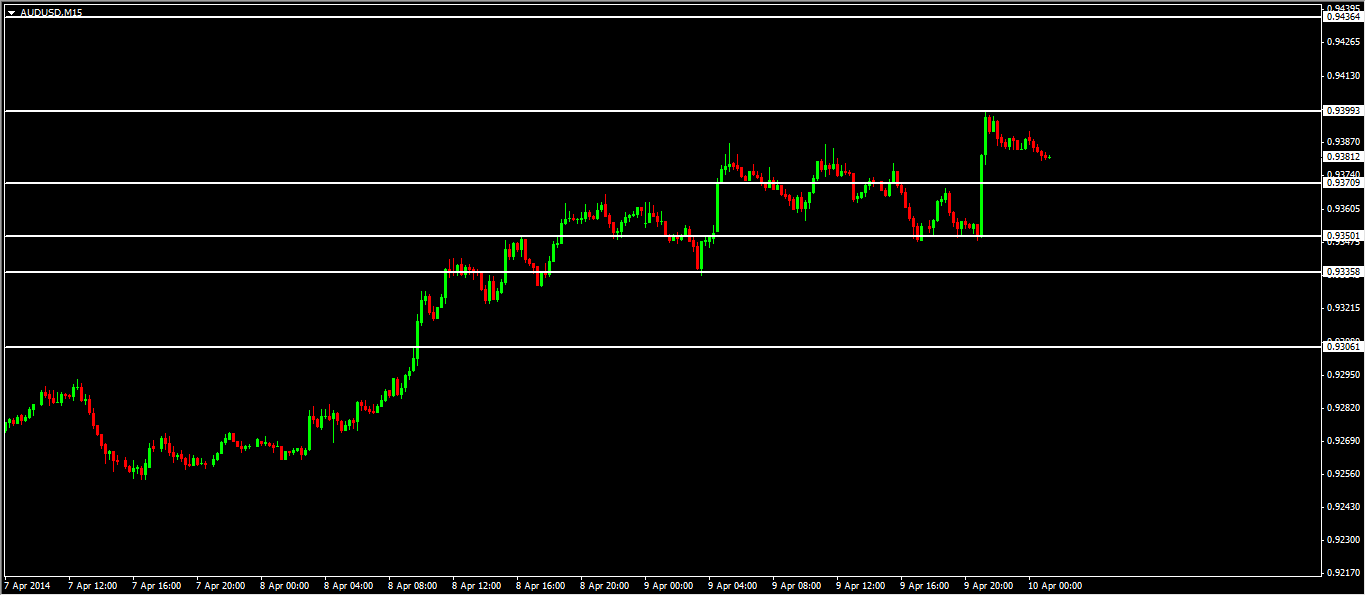The Australian Dollar continues to be the darling of the FX space in 2014, emboldened by a conglomerate of drivers; from carry trade plays, early expectations of rate hikes by the RBA (plus softer rhetoric towards AUD), assets returning into EMs (AUD proxy), and last but not least, the phenomenal performance AUD usually has during April (seasonals).
Immersing into the technicals, price action continues to scream we are in a 'buy on dips' type of market, with the latest breakout last Tuesday taking the price even beyond the topside of its daily channel, creating a clearance thrust allowing for a more parabolic trend. Amid such bullish indications, it seems safe to assume that looking to sell AUD at current levels (unless a more long term player) looks like a strategy still carrying high risks.
In these type of bullish markets, remember that many inexperienced players usually get caught selling based on overbought conditions, only to see, more often than not, the signal being ignored, with the march higher resuming until a technical cycle is complete or a fundamental trigger changes market perception towards holding AUD longs.
Could the AUD/USD soon be faced by one of the two scenarios mentioned above? Addressing the firs technical question, one validated pattern that garnered plenty of attention in recent weeks was the break of an inverted H&S pattern late March. Based on the initial target, since the distance between the head and the neckline is just over 400 pips, we will assume that price still has room to rise for a potential target of 0.95. The mere fact that no technical evidence has been given to invalidate the uptrend, is enough to remain technically bullish.
Looking at the fundamentals, today's Australian jobs data (due at 1.30GMT) could be one catalyst that distorts the uptrend. However, it is important not to forget that since the trend and sentiment are clearly bullish, it would take a significantly lower-than-expected reading to make some damage to AUD longs, as otherwise, on a slight negative deviation, risk remains high that Asia will continue to buy the dips.
For this month, expectations are low with the jobless rate expected at 6.1%, up 0.1% from February, with only between 2.5-5k jobs created. Possible scenarios can be found below:
Employment change well above 5k: AUD/USD is likely to target 0.9430/40, a level that converges with Nov 20, 2013 high, with further rises likely to encounter big clusters of selling at 0.95.
Employment change just above 5k: AUD/USD will most likely see a rise back above 0.94, with further upside risk towards 0.9430/40 not being ruled out given that sentiment is on the Aussie side.
Employment change between 2.5 and 5k: AUD/USD will probably have a tepid reaction, with any shallow downmove most likely to find grateful buyers. 0.94 could be retested, but no much follow through expected ahead of European trading.
Employment change marginally negative: AUD/USD could see a slide to test levels between 0.9350 and 0.9330/40 (retest of the 38.2 fib retrac from the nov-jan decline).
Employment change well below 0: AUD/USD will see an abrupt fall towards 0.9330/40 and probably see follow through for a retest of the 0.93 broken-resistance-turned-support.
Note: All information on this page is subject to change. The use of this website constitutes acceptance of our user agreement. Please read our privacy policy and legal disclaimer. Opinions expressed at FXstreet.com are those of the individual authors and do not necessarily represent the opinion of FXstreet.com or its management. Risk Disclosure: Trading foreign exchange on margin carries a high level of risk, and may not be suitable for all investors. The high degree of leverage can work against you as well as for you. Before deciding to invest in foreign exchange you should carefully consider your investment objectives, level of experience, and risk appetite. The possibility exists that you could sustain a loss of some or all of your initial investment and therefore you should not invest money that you cannot afford to lose. You should be aware of all the risks associated with foreign exchange trading, and seek advice from an independent financial advisor if you have any doubts.
Recommended Content
Editors’ Picks
EUR/USD clings to gains above 1.0750 after US data

EUR/USD manages to hold in positive territory above 1.0750 despite retreating from the fresh multi-week high it set above 1.0800 earlier in the day. The US Dollar struggles to find demand following the weaker-than-expected NFP data.
GBP/USD declines below 1.2550 following NFP-inspired upsurge

GBP/USD struggles to preserve its bullish momentum and trades below 1.2550 in the American session. Earlier in the day, the disappointing April jobs report from the US triggered a USD selloff and allowed the pair to reach multi-week highs above 1.2600.
Gold struggles to hold above $2,300 despite falling US yields

Gold stays on the back foot below $2,300 in the American session on Friday. The benchmark 10-year US Treasury bond yield stays in negative territory below 4.6% after weak US data but the improving risk mood doesn't allow XAU/USD to gain traction.
Bitcoin Weekly Forecast: Should you buy BTC here? Premium

Bitcoin (BTC) price shows signs of a potential reversal but lacks confirmation, which has divided the investor community into two – those who are buying the dips and those who are expecting a further correction.
Week ahead – BoE and RBA decisions headline a calm week

Bank of England meets on Thursday, unlikely to signal rate cuts. Reserve Bank of Australia could maintain a higher-for-longer stance. Elsewhere, Bank of Japan releases summary of opinions.
